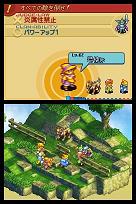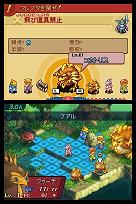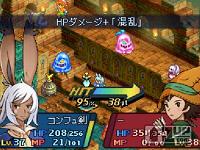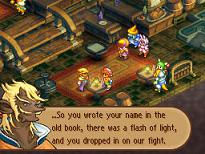Nearly five years ago, Final Fantasy Tactics Advance was released in North America, and it immediately became one of the more divisive games to carry the Final Fantasy moniker. Being more "kiddy" in appearance and theme, in addition to adding gameplay aspects such as Judges and Laws, made it a much-maligned follow-up to the more mature Final Fantasy Tactics. Then Final Fantasy XII showed how the new world of Ivalice could be serious. The latest title in the Ivalice Alliance series, Final Fantasy Tactics A2: Grimoire of the Rift, once again takes the player back into "kiddy" Ivalice, following in the footsteps of the Game Boy Advance title. Ultimately, without a great deal of improvement to the formula, and a few steps backwards, Final Fantasy Tactics A2 proves to be a similar experience, and some might argue, the lesser game.
Final Fantasy Tactics A2 features the same base system as its predecessor. The player takes control of a clan, which he fills with members of all willing races and assign jobs and equipment. Progress is quest-based, and these quests are taken up at the local pub for a small fee. When a battle begins, there may be a short preamble, and then units from the player's clan may be placed within the ever-familiar grid. Traps are sometimes placed on the battlefield and will end the turn of a unit who steps on one, as well as damaging or inflicting nasty status effects upon them. Most battles are an attempt to slaughter all of the opposing forces, though sometimes other objectives will arise, such as defeating a single foe, protecting a guest, gathering objects, or securing a particular spot. It's an old system, but it is a tried and true one. It's rather basic, but remains quite fun.
Laws and a new benefit called the "Clan Privilege" govern the battles. Each engagement has one consistent Law, and then the player may select a Privilege to apply extra benefits to all of their clan members. The list is wide, and can include receiving extra experience, more MP, stronger attack power, resistance to status effects, and many other buffs. One Privilege can even be received by loading a Final Fantasy Advance cartridge into the Game Boy Advance slot of the DS. A quiz at the beginning of the game determines one's starting Clan Privileges, and more are acquired through fighting Clan Trials.
 |
| Winding up, ready to fire. |
A few changes and additions have been applied to the Final Fantasy Tactics Advance formula. The MP system has been completely revamped to be something more like Tactics Ogre: all characters on the battlefield now begin with 0 MP and regenerate 10 each turn, forcing spellcasters to wait a while before unleashing meteors of death upon the battlefield. The amount regenerated can be increased through Clan Privileges, support abilities, or other means. A few new jobs have been added, including Magic Cannonneer, Devout, and Master Monk. Gria and Seeq, the newest races, each receive a whopping four jobs, three of which are unlocked by quests. Various jobs have received tweaks, such as Assassin, but for all the jobs that were fixed, some of the new ones are equally broken, like the Ranger. A few special characters are available to recruit, including Vaan and Penelo of Final Fantasy XII: Revenant Wings, and character-specific jobs are available, like Adelle's Heiress or Hurdy's Bard.
A brand new Auction system is a great way to gain control and influence over the world's territories. The world map is fixed, with five regions encompassing three or four provinces each. Every year, clan points may be put on the line to participate in a simple auction minigame to vy for supremacy and the title of Region King. Winning the first auction is pivotal to winning every single subsequent auction, and playing and winning enough times will open up a token shop for the auction, guaranteeing success. Region Kings will be able to compete not just for the provinces in the following year, but also prizes in the form of high-ranking equipment.
 |
| This giant cheeseburger shows up a number of times. This caption originally had the word "baddie" in there, but then my editor said "No, that's stupid, put in a more 'fun' word." So here we are. |
The largest change has been to the much-maligned Law system. No longer will characters go to jail for selecting the "Fight" command. Well, sort of. The negative penalties for laws have been drastically reduced, and one will never directly lose an engagement by breaking the Law, except in the case of Clan Trials. However, breaking the Laws means that fallen characters can not be revived, and the Clan Privilege is lost. In the late game, this can turn the tide of a battle, which wouldn't be so bad if the Laws weren't as aribitrary as in the first game. Laws like "Don't Miss" and "Don't Knock Back Foes" are things that the player simply has no control over, and laws like "Don't Hurt Weaker Foes" and "Don't Hurt Males" can make a quest long and drawn-out, though not challenging. Rewards are given post-battle if the Law isn't broken, but these don't become better as the game progresses.
So really, not much has changed at all about the Laws, except for one big thing that made the original Law system interesting and attractive in the first place: the fact that everyone followed the Laws or was penalized equally. That's right. Wandering monsters, opposing clans, and even guest characters can all merrily zip around the battlefield while the player is restricted to moving one square at a time, or buff themselves to the moon and back when good status changes are forbidden. The Judges themselves have changed, really, from serious business governors of Ivalice, to geezers in armour who follow the player's clan around and make only their lives miserable. The Law system hasn't changed for the better, overall, and has been modelled more like what it actually is: a system that creates little challenge, adds length, and merely annoys and inconveniences the player. What's the point of adding length to battles when there is no added challenge? The addition of one but lack of the other is jarring.
Another large stumbling block for Final Fantasy Tactics A2 is the interface. Despite the Nintendo DS's second screen, not much of the interface has been improved or streamlined, and the game relies too much on the linear interface of its predecessors. The Final Fantasy Tactics interface has not aged well. There's no excuse for the slow menus, and the long strings of A-A-A-B-B-B to go back and forth for viewing information or selecting battle options. It can be very difficult in battle to see a particular screen that displays elemental weaknesses, as there is no button to call it up. It just sometimes is there and sometimes isn't there. The top screen in battle displays the Law, Privilege and the turn order, but scrolling through the turn order is kind of clunky and doesn't display a great deal of information. The shop interface is a travesty. Items must be crafted from a list before they show up in the stores, but only certain ingredients may be used in certain combinations, and testing the combinations will involve scrolling through long lists of greyed-out ingredients to find the the single useable ingredient. Given the sheer number of categories and combinations and ingredients, the poor information display and the limited quantity of ingredients to work with, deciding what to do with that last ice shard can become a 15-minute affair. So much touchscreen potential just thrown to waste here.
 |
| Magic Fencer vs. Archer: no contest. |
Final Fantasy Tactics Advance, while having a kiddy exterior, had a story with interesting undertones (playing the role of the "bad guy" by shattering Marche's friends' dreams). This is not so with A2. The characters lack compelling motive and emotion. Luso Clemens is an assembly-line, peppy boy hero without real depth, Cid exists as a father figure who dispenses plot points, Adelle is a typical "kyaaa~" girl with a mysterious past, and Hurdy is Hurdy. The plot throws Luso into the world of Ivalice after he writes his name in a book, where he wholeheartedly embraces his relatively random adventures. There are some plot pacing issues, with serious story missions buried by "lol Vaan imposter" and "Let's go kill stuff for materials," quests. The villains have hijacked the power of the judges. Watch out, Luso! They have the power to destroy the world mess with your clan a little bit!
The best improvements have been in the graphical and musical departments. Both of these things have been undeniably polished. The 2D sprite graphics are detailed, battle effects are appropriately shiny, and the color palette is pleasant. The music is great, with lots of remixed FFTA and FFXII tunes as well as many good originals. A few of the songs are cued at inappropriate times, but other than that, there isn't much to complain about in the sound department.
 |
| That about covers it, Cid. |
Final Fantasy Tactics A2 has a lot of bulk on it for the completionist. Perfecting a clan, mastering the jobs and tackling the 300+ quests included in the game is more than enough for any fan of the gameplay. There might not be a lot of reason to replay the game, but a single playthrough can satisfy all cravings.
In the end, fans of the Final Fantasy Tactics Advance gameplay won't be disappointed, as the gameplay improvements and mistakes add up to marginally better than the original game. The battle system remains fun, a few epic battles are contained within, and the graphics and music have improved drastically. However, the bumbling interface, the "adjusted" Law system and the poor story will be a turnoff for many players. Final Fantasy Tactics A2 will please fans of the first, but other players should approach this beast carefully, as they may get bitten by disappointment. It ends up being an overall average-grade tactical RPG.